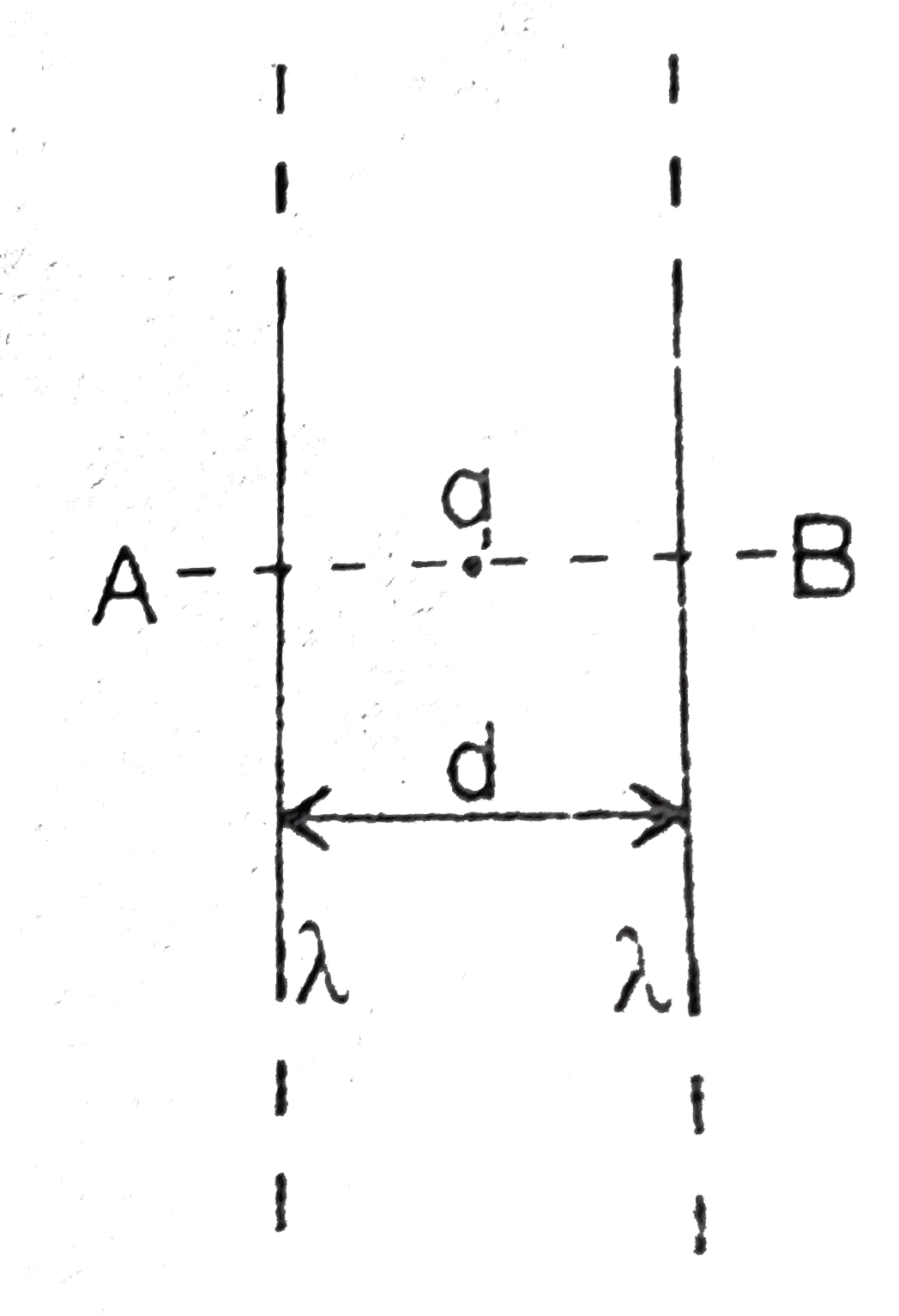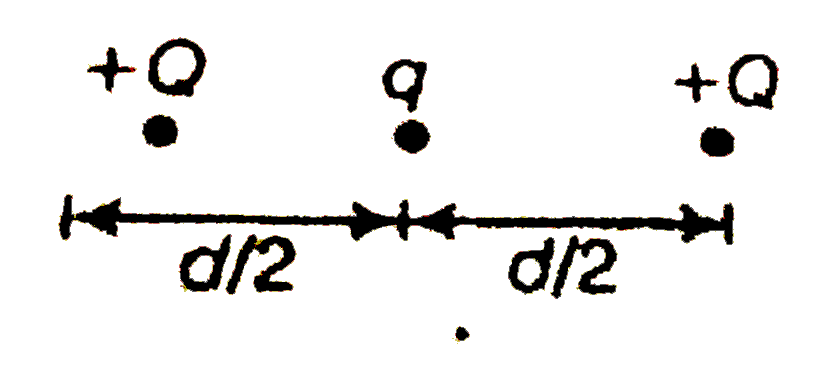A particle of mass m and charge q is located midway between two fixed charged particles each having a charge q and a distance 2l apart. Prove that the motion of the particle will be SHM if it is displaced slightly along the line connecting them and released. Also find its time period.
To solve the problem, we need to analyze the forces acting on the particle of mass m and charge q located midway between two fixed charged particles, each with charge q and separated by a distance 2l.
1. Understanding the Setup:
- Let the two fixed charges be Q1 and Q2, each with charge q.
- The distance between Q1 and Q2 is 2l.
- The particle of mass m and charge q is located at the midpoint, which is at a distance l from each charge.
2. Force Calculation:
- When the particle is displaced slightly to the right by a distance x, the new position of the particle will be l+x from Q1 and l−x from Q2.
- The force on the particle due to Q1 (to the right) is given by Coulomb's law:
F1=k⋅q2(l+x)2
- The force on the particle due to Q2 (to the left) is:
F2=k⋅q2(l−x)2
3. Net Force Calculation:
- The net force F acting on the particle when displaced by x is:
F=F1−F2=k⋅q2(l+x)2−k⋅q2(l−x)2
- To simplify this, we can use the binomial approximation for small x:
(l+x)−2≈1l2−2xl3
(l−x)−2≈1l2+2xl3
- Substituting these approximations into the force equation:
F≈kq2((1l2−2xl3)−(1l2+2xl3))
F≈kq2(−4xl3)=−4kq2l3x
4. Identifying Simple Harmonic Motion (SHM):
- The force F can be expressed as:
F=−kx
where k=4kq2l3.
- This is the form of Hooke's law, indicating that the motion is simple harmonic.
5. Finding the Time Period:
- The time period T of SHM is given by:
T=2π√mk
- Substituting k:
T=2π
⎷m4kq2l3=2π√ml34kq2=π√ml3kq2
Final Result:
The motion of the particle will be simple harmonic motion (SHM) if displaced slightly along the line connecting the two charges, and the time period of the motion is given by:
T=π√ml3kq2
- Let the two fixed charges be Q1 and Q2, each with charge q.
- The distance between Q1 and Q2 is 2l.
- The particle of mass m and charge q is located at the midpoint, which is at a distance l from each charge.
- When the particle is displaced slightly to the right by a distance x, the new position of the particle will be l+x from Q1 and l−x from Q2.
- The force on the particle due to Q1 (to the right) is given by Coulomb's law:
F1=k⋅q2(l+x)2
- The force on the particle due to Q2 (to the left) is:
F2=k⋅q2(l−x)2
- The net force F acting on the particle when displaced by x is:
F=F1−F2=k⋅q2(l+x)2−k⋅q2(l−x)2
- To simplify this, we can use the binomial approximation for small x:
(l+x)−2≈1l2−2xl3
(l−x)−2≈1l2+2xl3
- Substituting these approximations into the force equation:
F≈kq2((1l2−2xl3)−(1l2+2xl3))
F≈kq2(−4xl3)=−4kq2l3x
- The force F can be expressed as:
F=−kx
where k=4kq2l3.
- This is the form of Hooke's law, indicating that the motion is simple harmonic.
- The time period T of SHM is given by:
T=2π√mk
- Substituting k:
T=2π
⎷m4kq2l3=2π√ml34kq2=π√ml3kq2
The motion of the particle will be simple harmonic motion (SHM) if displaced slightly along the line connecting the two charges, and the time period of the motion is given by:
T=π√ml3kq2
Topper's Solved these Questions
- BOOK - RESONANCECHAPTER - ELECTROSTATICSEXERCISE - Problems22videos
ELECTROSTATICS
- BOOK - RESONANCECHAPTER - ELECTROSTATICSEXERCISE - Exercise-1 Section (A)9videos
ELECTROSTATICS
- BOOK - RESONANCECHAPTER - ELECTROMAGNETIC INDUCTIONEXERCISE - A.l.P19videos
ELECTROMAGNETIC INDUCTION
- BOOK - RESONANCECHAPTER - EXPERIMENTAL PHYSICSEXERCISE - PART -II10videos
EXPERIMENTAL PHYSICS
Similar Questions
A particle of mass m and charge +q is located midway between two fixed charged particles each having a charge +q and at a distance 2L apart. Assuming that the middle charge moves along the line joining the fixed charges, calculate the frequency of oscillation when it is displaced slightly.
View SolutionTwo infinitely long line charges having charge density λ each are parallel to each other and separated by distance d. A charge particle of mass m and charge q is placed at mid point between them. This charge displaced slightly along a line AB which is perpendicular to the line charges and in the plane of the charges. prove that the motion of the particle will be SHM for small displacement and λq>0 Neglect gravity. Find the time period.
 View Solution
View Solution
Knowledge Check
- Question 1 - Select One
A particle of mass m and charge q is located midway between two fixed charged particles each having a charge q and at a distance 2L apart so that distance of this charge from each charge located at end is L. Assuming that the middle charge moves along the line joining the fixed charges. The frequency of oscillation when it is displaced slightly is
Aqπ√mπε0L3Bq4π(mπε0L3)C2qπ√mπε0L3Dq2π√mπε0L3 - Question 2 - Select One
A particle of mass m and charge q is placed at rest in a uniform electric field E and then released, the kinetic energy attained by the particle after moving a distance y will be
Aq2EyBqEyCaE2yDqEy2 - Question 3 - Select One
Two positively charged particles each having charge Q and are d distance apart. A third charge is introduced in midway on the line joining the two charges. Find the nature and magnitude of third charge so that the system is in equilibrium.
 Aq=Q4Bq=Q4Cq=3Q4Dq=−3Q4
Aq=Q4Bq=Q4Cq=3Q4Dq=−3Q4
Two points charges , each Q , are fixed at separation 2d. A charged particle having charge q and mass m is placed between them.
(a) Now this charged particle is slightly displaced along the line joining the charges , slow that it will execute simple harmonic motion and find the time period of oscillation.
(b) If charge q is negative and it is displaced slightly perpendicular to the line joining the charges , repeat the part (a).View SolutionA particle of mass m and charge -q moves along a diameter of a uniformluy charged sphere of radinus R and carrying a total charge +Q. Find the frequency of S.H.M. of the particle if the amplitude does not exceed .
View SolutionA thin fixed ring of radius 'R' and positive charge 'Q' is placed in a vertical plane. A particle of mass 'm' and negative charge 'q' is placed at the centre of ring. If the particle is given a small horizontal displacement, show that it executes SHM. Also find the time period of small oscillations of this particle, about the centre of ring. (Ignore gravity)
View SolutionA particle of mass m carrying a charge −q1 starts moving around a fixed charge +q2 along a circulare path of radius r. Find the time period of revolution T of charge −q1.
View SolutionAs shown in the adjoining figure two charge particles each having charge q and mass m and d distance apart from each other. If two particle in equilibrium under the gravitational and electric force, then determine the ratio q/m.
 View Solution
View Solution

